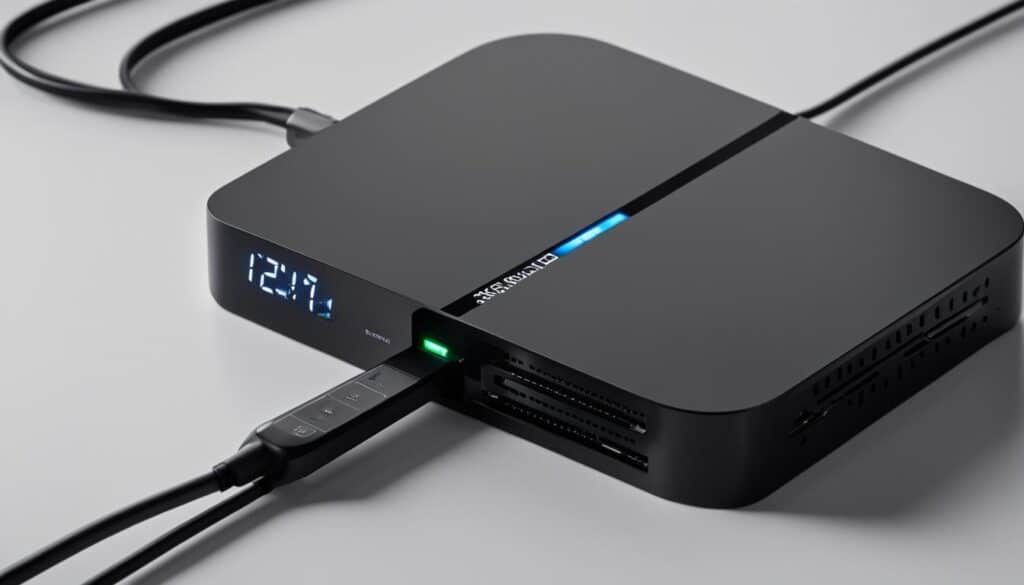In this easy guide, I will take you through the first steps of setting up your smart home network. With the increasing popularity of smart devices and the Internet of Things (IoT), creating a connected and seamless experience in your home has become easier than ever. By following this step-by-step guide, you’ll be able to link your devices and enjoy the convenience and automation that a smart home offers.
Table of Contents
Key Takeaways:
- Setting up a smart home network is now easier than ever.
- A smart home network allows devices to communicate and be controlled remotely.
- Choose the right smart home hub for compatibility and ease of use.
- Connect your devices to the smart home network following manufacturer instructions.
- Create automation and customize settings to tailor your smart home network to your needs.
Understanding Smart Home Networking
Before diving into the setup process, it’s important to understand the basics of smart home networking. A smart home network is a system that allows multiple devices, such as thermostats, lights, cameras, and appliances, to communicate with each other and be controlled remotely. This is made possible through wireless connectivity, typically using Wi-Fi, Bluetooth, or Zigbee protocols. The Internet of Things (IoT) is the network of physical devices embedded with sensors, software, and other technologies to exchange data with other devices and systems over the internet. By having a clear understanding of these concepts, you’ll be better prepared to set up your smart home network.
Smart home networking allows devices in your home to communicate with each other and be controlled remotely.
The interconnectedness of devices is what makes a smart home an efficient and convenient living space. Imagine being able to control your lights, adjust your thermostat, or monitor your security cameras all from your smartphone or with a simple voice command. Smart home networking brings this level of automation and convenience to your fingertips.
With a growing number of connected devices, the Internet of Things (IoT) has transformed the way we interact with our homes. From smart speakers and voice assistants to smart thermostats and door locks, these devices can now seamlessly integrate into a single network, creating a truly interconnected home environment.
Wireless connectivity is the key enabler for smart home networking. Wi-Fi is widely used for high-bandwidth devices like streaming media players and security cameras, while Bluetooth is commonly utilized for short-range wireless connections, such as smart locks and light bulbs. Zigbee is another popular wireless protocol for smart home devices that offers low power consumption and strong reliability.
Smart home networking brings automation and convenience to your fingertips.
By leveraging wireless connectivity, your smart home devices can communicate with each other and with your smartphone or voice assistant. This means you can control them individually, create custom settings, or even automate tasks based on specific conditions or schedules.
Understanding the fundamentals of smart home networking is crucial before setting up your smart home. It will help you make informed decisions when choosing devices, configuring your network, and troubleshooting any connectivity issues that may arise.
Choosing the Right Smart Home Hub
When it comes to setting up your smart home network, selecting the right smart home hub is a critical first step. A smart home hub serves as the central control for all your connected devices, offering you the convenience of managing and automating them from a single platform.
As you embark on your search for the perfect smart home hub, there are a few key factors to consider. One of the most important considerations is compatibility. Ensure that the hub you choose is compatible with your existing devices to avoid any compatibility issues down the line.
Additionally, integration with popular voice assistants like Amazon Alexa or Google Assistant is a significant advantage. Voice assistants provide a hands-free experience, allowing you to control your smart home devices through simple voice commands.
To summarize, when selecting your smart home hub, keep in mind the following:
- Compatibility with your existing devices
- Integration with voice assistants
| Smart Home Hub | Compatibility | Integration with Voice Assistants |
|---|---|---|
| Hub A | Yes | Yes (Amazon Alexa, Google Assistant) |
| Hub B | Yes | No |
| Hub C | No | Yes (Amazon Alexa) |
By considering compatibility and integration with voice assistants, you can ensure a seamless and hassle-free experience when managing your smart home.
Next, we’ll move on to the process of connecting your devices to the smart home network for complete control and automation.

Connecting Your Devices to the Smart Home Network
Now that you have your smart home hub, it’s time to connect your devices to the smart home network. This step is crucial to ensure that all your devices can communicate with each other and be controlled seamlessly.
The process of connecting devices to the smart home network involves device pairing and network setup. Here’s a step-by-step guide to help you get started:
- Check Device Compatibility: Before pairing your devices, make sure they are compatible with your chosen smart home hub. Check the manufacturer’s specifications or consult the hub’s documentation for a list of supported devices.
- Pair Devices with the Hub: Follow the manufacturer’s instructions to pair each device with the smart home hub. This usually involves putting the device in pairing mode and using the hub’s control interface to initiate the pairing process.
- Configure Device Settings: Once your devices are paired, you may need to configure certain settings to enable smooth operation within the smart home network. This could include setting device names, assigning specific rooms or zones, or adjusting individual device preferences.
- Install Mobile Apps: To control and manage your devices from your smartphone or tablet, you may need to install specific mobile apps provided by the device manufacturers or the smart home hub. These apps will allow you to monitor and control your devices remotely.

Image: Device compatibility
By following these steps, you’ll be able to connect your devices to the smart home network and enjoy the convenience of controlling them from a central hub or your mobile device. Remember to refer to the manufacturer’s instructions for any specific device pairing and configuration steps.
| Device | Compatibility | Mobile App |
|---|---|---|
| Smart Thermostat | Compatible with most smart home hubs | Smart Thermostat App |
| Smart Light Bulbs | Compatibility varies based on manufacturer | Smart Lighting App |
| Smart Security Camera | Compatible with select smart home hubs | Security Camera App |
| Smart Speaker | Compatible with popular voice assistants | Voice Assistant App |
Creating Automation and Customization
One of the key benefits of a smart home network is the ability to automate tasks and customize settings according to your preferences. With the power of automation, you can save time and effort by letting your smart devices take care of routine tasks for you.
One way to automate your smart home is by creating schedules. Whether it’s turning on the lights at a specific time each day or adjusting the thermostat before you wake up, schedules allow you to set your devices to operate on a predetermined timetable. This helps create a consistent and comfortable environment without the need for manual intervention.
Another option for customization is setting up smart home routines. These routines allow you to activate multiple actions with a single voice command or trigger. For example, with a simple phrase like “Goodnight,” you can automatically lock the doors, turn off the lights, and adjust the temperature to create a cozy bedtime environment.
Furthermore, you have the freedom to customize settings for different scenarios. Whether you’re hosting a party or enjoying a movie night, you can adjust the lighting, music, and temperature to suit the occasion. This level of personalization creates a tailored smart home experience that aligns with your lifestyle.
To explore these features and settings, start by accessing the user interface of your smart home hub or associated mobile app. This interface provides a centralized location where you can view and manage your connected devices. From there, you can set up schedules, create routines, and adjust settings to unleash the full potential of your smart home network.
Benefits of Automation and Customization
- Enhanced convenience: By automating repetitive tasks, you can streamline your daily routine and focus on activities that matter most to you.
- Energy efficiency: Scheduling devices to operate only when needed can help conserve energy and reduce utility costs.
- Comfort and ambiance: Customizing settings allows you to create the perfect ambiance for different activities or moods.
- Peace of mind: Smart home routines can provide added security, such as automatically locking doors and activating security cameras.
- Adaptability: With automation and customization, your smart home can adapt to changes in your daily life and requirements.
Expert Tip: Building Complex Automations
When it comes to automation, don’t be afraid to get creative and think outside the box. Experiment with different combinations of actions and triggers to create complex automations that cater to your specific needs. Remember to test and refine your automations regularly to ensure they work seamlessly in your smart home ecosystem.
Ensuring Security and Privacy
When it comes to your smart home network, prioritizing security and privacy is crucial. By implementing these measures, you can protect your smart home from potential threats and safeguard your personal information.
To strengthen your smart home security, follow these essential steps:
- Keep firmware up to date: Manufacturers regularly release firmware updates to address security vulnerabilities. Make sure to check for updates and install them promptly to ensure your devices are protected.
- Use strong passwords: Create unique, complex passwords for your smart home accounts. Avoid using common phrases or easily guessable information. Consider using a password manager to store and manage your passwords securely.
- Enable two-factor authentication: Add an extra layer of security by enabling two-factor authentication wherever possible. This will require additional verification, such as a verification code sent to your mobile device, when accessing your smart home accounts.
- Review privacy settings: Take the time to review the privacy settings on your smart home hub and connected devices. Adjust the settings according to your preferences, ensuring that your devices collect only the necessary data and limit any potential sharing of personal information.
“Protecting your smart home is as important as protecting your physical home. Stay proactive and vigilant when it comes to security and privacy to enjoy the full benefits of your smart home network.”
– [First Name Last Name], Smart Home Security Expert
By implementing these security measures, you can have peace of mind knowing that your smart home is secure and your personal data is protected. Remember, a strong defense is the key to enjoying a safe and enjoyable smart home experience.
| Benefits of Ensuring Security and Privacy in Your Smart Home | Actions |
|---|---|
| Data Protection | Regularly update firmware Use strong passwords and enable two-factor authentication Review privacy settings on devices |
| Prevention of Unauthorized Access | Regularly check for and install firmware updates Create strong and unique passwords Enable two-factor authentication |
| Peace of Mind | Knowing your personal information is protected Feeling secure in the privacy of your own home |
| Reduced Risk of Data Breaches | Stay up to date with firmware updates Create strong and unique passwords Limit data sharing and review privacy settings |
Conclusion
Now that you’ve completed the first steps in setting up your smart home network, you’re well on your way to enjoying the convenience and automation that a smart home offers. By following this easy setup guide and understanding the basics of smart home networking, you’ve connected your devices and are ready to make your home smarter than ever.
With a wide range of connected devices at your fingertips, you can control everything from lights and thermostats to security cameras and appliances with a simple tap on your smartphone or a voice command to your smart home hub. Imagine the ease of adjusting your lighting to set the perfect ambiance for a cozy movie night or having your coffee ready as you wake up, all thanks to smart home automation.
But it doesn’t end there. Don’t forget to explore the various automation and customization options available to you. By creating schedules, smart home routines, and custom settings, you can tailor your smart home network to fit your lifestyle and preferences. Whether it’s automatically turning on your lights when you arrive home or adjusting your thermostat based on your daily routine, the possibilities for personalization are endless.
FAQ
What is a smart home network?
A smart home network is a system that allows multiple devices, such as thermostats, lights, cameras, and appliances, to communicate with each other and be controlled remotely through wireless connectivity.
How do I choose the right smart home hub?
When choosing a smart home hub, it’s important to consider compatibility with your existing devices and the ability to integrate with popular voice assistants like Amazon Alexa or Google Assistant.
How do I connect my devices to the smart home network?
To connect your devices to the smart home network, you’ll need to pair each device with the hub and follow the manufacturer’s instructions for network setup. You may also need to install specific mobile apps for device control and management.
Can I customize the automation and settings in my smart home network?
Yes, one of the benefits of a smart home network is the ability to automate tasks and customize settings. You can create schedules, set up smart home routines, and customize settings for different scenarios according to your preferences.
How can I ensure security and privacy in my smart home network?
To ensure security and privacy in your smart home network, it’s important to keep your smart home hub and devices up-to-date with firmware updates. Use strong, unique passwords for your smart home accounts and enable two-factor authentication whenever possible. Review privacy settings and understand data sharing practices to protect your privacy.


